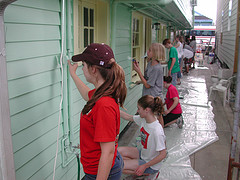Disaster relief volunteer needs continue long afterwards
 In the immediate aftermath of natural disasters, one thing is certain: Help is always needed. For vagabonders who are drawn to giving back to the global community, especially when times are tough, this offers a wide variety of ways to get closer to a culture. But what happens when the media coverage dies down and attention moves on to the next big thing?
In the immediate aftermath of natural disasters, one thing is certain: Help is always needed. For vagabonders who are drawn to giving back to the global community, especially when times are tough, this offers a wide variety of ways to get closer to a culture. But what happens when the media coverage dies down and attention moves on to the next big thing?
While emergency needs in rebuilding a community may wane to a degree, natural disaster damage lingers long afterwards. In Indonesia, progress has been made in restoring health services since the 2004 tsunami, however residents in rural areas are still unable to access basic health care. The American Red Cross and its local partners continue to train volunteers to educate individuals in 140 villages about disease prevention.
The floodwaters from Hurricane Katrina have drained, but rebuilding assistance is still needed in New Orleans. Daily projects run by Habitat for Humanity, the St. Bernard Project and HandsOn New Orleans allow visitors to help residents of the Crescent City get a new place to live.
In 1998, Hurricane Mitch stalled over the Honduran island of Guanaja for three days, killing people, destroying homes and devastating the island’s natural resources. Today, residents have rebuilt and gotten back to daily life. But some areas of the island that used to be great mangrove forests have never recovered. I just returned from a trip to Guanaja where I was one of only two people who planted more than 2,000 mangrove pods—just a small part to help the area regain some of its native mangrove forests.
Whether it’s a large, internationally organized effort, or a small contribution by a handful of people, every little bit helps a community recover from a disaster—even years later.

November 2nd, 2009 at 11:17 am
Great point about how relief continues after a disaster. As a society, we don’t think about this. We move from disaster to disaster as if we are traveling from city to city. It’s something to think about the next time a natural disaster occurs. People still require help.